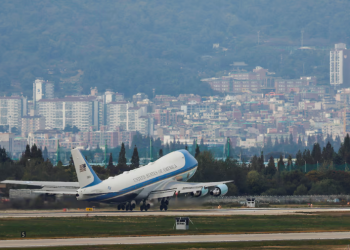The U.S. Navy’s introduction of the AIM-174B, a new long-range air-to-air missile, could significantly alter the balance of power in the South China Sea, according to experts. The AIM-174B, derived from the Raytheon SM-6 missile, was officially revealed in July and is now the longest-range air-to-air missile in the U.S. arsenal, with a reach of up to 400 kilometers (250 miles). This development comes as tensions in the Indo-Pacific region continue to rise, particularly between the U.S. and China.
The missile’s capabilities are particularly notable in the context of its range, which outstrips China’s PL-15 missile by 150 kilometers (93 miles). This enhanced reach allows U.S. aircraft to strike targets from a safer distance, thereby reducing the risk to U.S. carrier groups and extending the range of potential strikes on high-value Chinese targets, including command-and-control planes.
“The AIM-174B could enable the U.S. to protect its key assets and engage PLA targets from a much safer distance,” said Chieh Chung, a researcher at the Association of Strategic Foresight in Taipei. The missile’s deployment could also influence China’s military strategy in the region, particularly in any potential conflict within the First Island Chain, which spans from Indonesia to Japan.
The AIM-174B’s impact on U.S. naval operations could be profound. For decades, U.S. military power in the air was dominated by the AIM-120 AMRAAM, which has a maximum range of about 150 kilometers (93 miles). This required U.S. aircraft to operate closer to enemy forces, increasing the risk of anti-ship missile attacks. However, with the AIM-174B, U.S. forces can now engage targets at a significantly greater distance, enhancing their operational safety and effectiveness.
One of the key advantages of the AIM-174B is that it does not require new production lines, as it is based on the existing SM-6 missile. This means that the U.S. Navy can quickly ramp up production to meet demand, with funding already allocated for the production of over 100 SM-6 missiles annually.
The missile’s introduction also strengthens the U.S. military’s partnership with Australia, a crucial ally in the region. The AIM-174B is compatible with the F/A-18E/F Super Hornet aircraft, which are operated by both the U.S. and Australian air forces. Australia’s Defense Ministry confirmed close cooperation with the U.S. to explore capabilities that could be integrated into their defense strategy.
The strategic implications of the AIM-174B are already evident. A senior U.S. defense analyst, who requested anonymity due to the sensitive nature of the topic, noted that the missile’s range advantage could force China to rethink its military tactics in the region. “This missile holds the potential to change Chinese behavior, as it puts large, slow-moving aircraft at greater risk, even those involved in an invasion of Taiwan,” the analyst said.
The AIM-174B’s versatility extends beyond air-to-air combat. The SM-6 has been used in various roles, including targeting ships and land-based missile systems. This adaptability could further enhance the U.S. Navy’s capabilities in the South China Sea, where the ability to strike from a distance is crucial.
Read more on The price of power: U.S. spends $13.6bn yearly to maintain military aircrafts





















